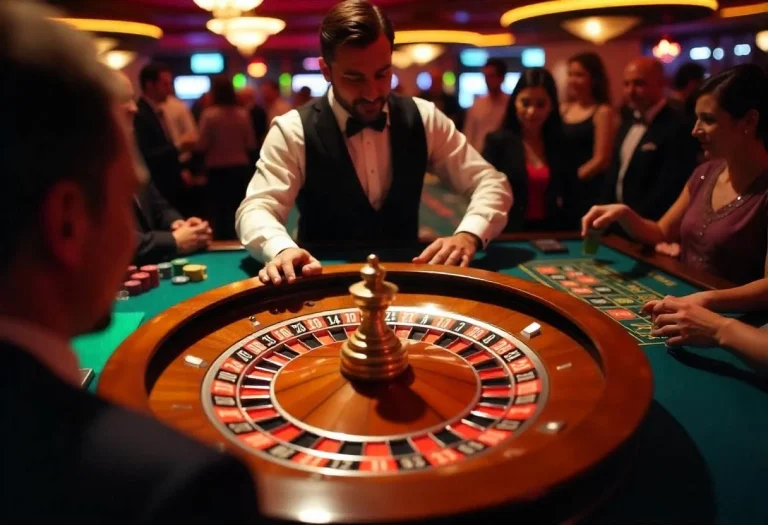The European Roulette spinning wheel, the ball dancing around its rim, chips placed on the betting layout, observant croupiers, and the excitement of players surrounding the table—these iconic images have defined the atmosphere of casinos for centuries. Roulette, one of the oldest and most revered casino games, is an enduring favorite among players. It’s a simple yet captivating game that offers pure chance and thrills, making it a timeless classic.
Since its creation in the 18th century as a byproduct of scientific exploration, roulette has been a fixture in casinos worldwide. Its popularity gave rise to three distinct variations: European, American, and French roulette. Each offers unique gameplay experiences, and while they are easy to learn, mastering them requires skill, strategy, and understanding the betting systems developed over the years.
With the rise of online gambling, roulette transitioned seamlessly into the digital realm, allowing players to experience the game from the comfort of their homes. Today, European roulette stands as one of the most popular and sought-after variants in online casinos, attracting both beginners and seasoned players.
In this article, we’ll dive into the nuances of European roulette, highlighting its distinctive features, advantages, and how it differs from its American and French counterparts.
A Brief History of European Roulette
The origins of roulette can be traced back to the 15th to 17th centuries, during the rise of a lottery-based game called Biribi, which was popular in Italy at the time. This simple game, which allowed players to wager on numbers drawn from a set, had its share of controversies due to cheating incidents, eventually leading to its ban in 1873.
Meanwhile, in France, mathematician Blaise Pascal was working on creating a perpetual motion machine. Though he failed in his quest, his invention of the spinning wheel inadvertently led to the creation of roulette. By combining Pascal’s wheel with the layout of Biribi, roulette was born.
Roulette quickly became a sensation in Paris, appearing at the Palais Royal Casino by 1796, and soon spread to Monte Carlo and other major gambling hubs. The game originally featured 36 numbers plus two zeros: ‘0’ and ‘00’. This dual-zero layout is a hallmark of the American roulette version. However, in 1843, a French casino owner named Francois Blanc introduced a version with only a single zero, creating what we now know as European roulette. This alteration reduced the house edge and made the game more appealing to players, allowing it to gain widespread popularity across Europe.
Wheel and Table Layout in European Roulette
There are 37 pockets on the European roulette wheel: 36 numbers (numbered 1–36), plus one zero. Due to this arrangement, European roulette differs significantly from its American equivalent, which has 38 pockets overall, including a double-zero pocket.
The house edge, which is 2.7%, is the main benefit of the European edition. In comparison, the additional double-zero pocket in American roulette results in a bigger house edge of 5.26%. Because it has superior odds, European roulette is therefore the one that most players choose.
There are no even and odd numbers next to each other, nor are there any low and high numbers next to each other; the wheel’s number sequence is distinct. 0, 32, 15, 19, 4, 21, 2, 25, 17, 34, 6, 27, 13, 36, 11, 30, 8, 23, 10, 5, 24, 16, 33, 1, 20, 14, 31, 9, 22, 18, 29, 7, 28, 12, 35, 3, and 26 are the numbers in that order.
Understanding European Roulette Rules
The rules of European roulette are straightforward, making it accessible to new players while still offering depth for more experienced ones. The dealer spins the wheel counterclockwise, while the ball spins in the opposite direction. The dealer will not allow any more bets until he says, “No more bets.”
Inside and outside bets are the two categories of wagers in roulette.
Inside bets involve wagering on individual numbers or small groups of numbers, while outside bets cover larger groupings such as odd/even, red/black, or high/low numbers.
An interesting feature of European roulette is the En Prison rule, which applies to even-money bets. If the ball lands on zero, players have the option to either “imprison” their bet for the next spin or forfeit half of it. This rule reduces the house edge further, making the game even more favorable to players, lowering the edge to 1.35%.
Betting Systems, Payouts, and Strategies
European roulette offers various betting options, each with different payouts. Inside bets, such as the straight bet (placing chips on a single number), pay the highest at 35:1. Other inside bets include the split bet (two adjacent numbers, paying 17:1), street bet (three numbers, 11:1), and corner bet (four numbers, 8:1).
Outside bets involve larger combinations, such as betting on red or black, odd or even, or high or low numbers. These bets typically pay 1:1 or 2:1, depending on the wager.
To maximize your chances of success, many players turn to various betting strategies, including the Martingale, Fibonacci, and Paroli systems. These strategies offer different approaches to bankroll management and risk-taking, allowing players to adjust their bets based on wins and losses.
The Online European Roulette Experience
The digital version of European roulette mirrors its land-based counterpart, with slight variations in table layouts depending on the online platform or device used. The experience, however, remains largely the same, providing the same excitement and thrill of the spinning wheel.
To ensure a fair and transparent experience, it’s crucial to play at reputable online casinos regulated by trustworthy gaming authorities. Players should also be aware of how Random Number Generators (RNGs) work, as they determine the outcome of each spin in online roulette.
For a more immersive experience, many online casinos offer live dealer roulette, where real-life dealers spin the wheel in real-time, enhancing the authenticity of the gameplay.
Conclusion
European roulette continues to be one of the most beloved casino games worldwide, thanks to its simple rules, low house edge, and thrilling gameplay. Whether played in land-based casinos or online, it offers an exhilarating experience that has stood the test of time.
For new players, it’s important to learn the rules, understand the different types of bets, and experiment with various betting systems. But above all, always play responsibly and within your budget. Whether you win big or experience a losing streak, the joy of playing European roulette lies in the excitement and anticipation of each spin.



